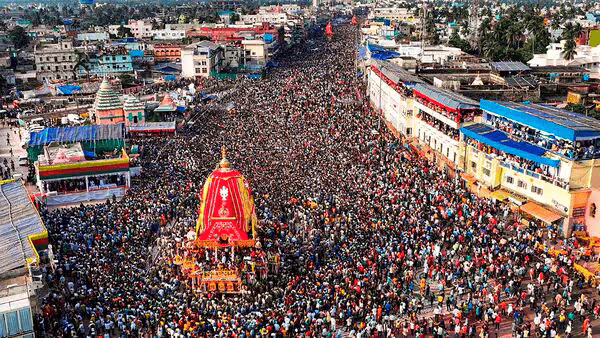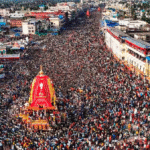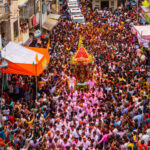Millions of people gather to witness a miraculous phenomena every year, the Jagannath Yatra, which turns the holy city of Puri in Odisha into a glittering sea of devotion, color, and chants. More than a festival, it’s a breathtaking spiritual parade where deities ride colossal wooden chariots through cheering crowds.For ages, it has endured as a celebration of harmony, divinity, and unending faith.

The Myth That Moves Millions
According to ancient legend, Lord Jagannath, an incarnation of Krishna, yearns to visit his birthplace once a year. When Krishna and his siblings, Balabhadra and Subhadra, set out on an epic trip from the Jagannath Temple to the Gundicha Temple during the Yatra, this sincere wish comes true. The purpose of this journey is deeply spiritual — it symbolizes the Lord’s love for his devotees and his willingness to come out of the sanctum to bless everyone, including those who cannot enter the temple due to various social restrictions. This journey reflects the deep compassion and inclusivity of Jagannath, whose name itself means “Lord of the Universe.”
More Than a March — A Movement of the Soul
The Yatra isn’t just a procession. It’s the soul’s symbolic voyage toward liberation. Caste, class, and status dissolve in the ocean of faith. Devotees from all walks of life unite to pull the ropes of the grand chariots — an act considered as sacred as prayer. This ritual signifies collective spiritual effort and the idea that everyone, regardless of background, can help bring the divine closer to the people. The act of physically pulling the chariots symbolizes the devotee’s desire to bring God into their own lives and hearts.
Epic Rituals and Living Traditions
Weeks before the Yatra, skilled artisans begin building the enormous chariots — each towering up to 45 feet and made anew every year using sacred wood and traditional methods. This construction is not just craftsmanship but a sacred duty performed by generations of temple-servant families. On the day of the Yatra, the ‘Pahandi’ procession begins, where the idols are carried out with immense fanfare amid drumbeats, conch shells, and cries of “Jai Jagannath!”

The three resplendent chariots — Nandighosa (Jagannath), Taladhwaja (Balabhadra), and Darpadalana (Subhadra) — roll along the Grand Road (Bada Danda) to the Gundicha Temple, greeted by oceans of devotees.The deities’ presence at this temple is symbolic of a family visit, as it is thought that Lord Jagannath’s aunt was born there. After nine days, the Bahuda Yatra (return journey) brings them back, completing the sacred cycle and returning the divine siblings to their home.
Important Dates and Travel Tips
The Jagannath Rath Yatra usually takes place in June or July, during the Hindu month of Ashadha. In 2025, the Yatra is expected to begin on 29th June, with the Bahuda Yatra occurring on 7th July. Other significant dates include Hera Panchami (3rd July) and Suna Besha (Golden adornment of the deities, 8th July).
For travelers, the nearest airport is Biju Patnaik International Airport in Bhubaneswar, about 60 km from Puri. From there, affordable transport options like buses, taxis, and trains are readily available. Train connections from major Indian cities like Delhi, Kolkata, and Chennai make it easy to reach Puri economically. Budget accommodations, dharamshalas, and temple guesthouses are available, but it is recommended to book early due to the massive tourist rush.
Famous Local Dishes to Try
A trip to Puri isn’t complete without tasting its flavorful cuisine.The Jagannath Temple is renowned for having one of the biggest outdoor kitchens in the world, and food plays a significant role in the spiritual experience in Puri.

Some must-try dishes include:
- Mahaprasad: Offered at the Jagannath Temple and served on eco-friendly plates, it includes rice, dal, curry, and sweets. It is considered sacred and is shared among all devotees as a blessing.
- Chhena Poda: A baked dessert made of cottage cheese and sugar, unique to Odisha.
- Dalma: A nutritious lentil and vegetable stew seasoned with traditional spices — a staple in Odia households.
- Khaja: A crispy sweet snack often served as temple prasad, made with layered dough and sugar syrup.
- Rasabali: Deep-fried cheese patties soaked in thickened, sweetened milk — rich and festive.
When Faith Crosses Borders
Thanks to ISKCON and the Odia diaspora, the Jagannath Yatra has spread from New York to Nairobi, London to Tokyo. These international celebrations help spread awareness about Indian culture, showcasing the universal appeal of devotion, inclusiveness, and community spirit. Chariots are constructed, processions held, and chants of Hare Krishna echo in foreign lands, symbolizing how faith knows no boundaries. No matter where it’s celebrated, the essence remains the same — devotion in motion, hearts connected by divine rhythm.










